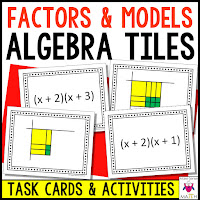Tell me if this scenario sounds familiar. You are planning your classes for next week and you notice that your students will need to learn to multiply binomials. You are so excited, because you have a great trick to teach your students, and it's SO easy, right? If your kids can just remember the acronym F.O.I.L., then they'll have the concept learned in no time. This may have been the way you learned to multiply binomials, you know your students will catch on in no time. Many teachers use F.O.I.L. to teach multiplying binomials such as (x + 3)(x + 4). The F. represents FIRST, multiply first terms. x(x) = x2 Next comes O. = outside terms x(4) = 4x, then I.= inside terms 3(x) = 3x then L. = last terms 3(4) = 12. Combining the terms we have x2 + 4x + 3x + 12 = x2 + 7x + 12. Voila...you can multiply binomials. O.K. I hope I'm not convincing you to use F.O.I.L. I'll give you some credit, F.O.I.L., is usually easy for the kids to learn and memorize (if they can memorize), however teaching F.O.I.L. has many, many downfalls. Let me explain why I NEVER will teach my kids F.O.I.L.
Why I Will Never Teach F.O.I.L.
1) F.O.I.L., has no mathematical basis. Your quick memorizers may attach quickly to F.O.I.L. and zoom through their 20 practice problems that you have assigned them. However, ask them to explain why F.O.I.L. works and they will stare at you blankly. Generally, if students do not understand why an algorithm works they will not be able to retain the concept, or they will not be able to apply the concept to new skills. Also, if you are just teaching a shortcut, are you really teaching pure mathematics?
2) What about the students who can't memorize? F.O.I.L., is based on the assumption that all students can memorize the acronym, what each letters stands for, and when to apply it. If you haven't learned already, you soon will, all kids are not great memorizers. The ability to memorize should not be a requisite for being a mathematician, rather the ability to reason and problem-solve. As a teacher you should work to develop reasoning and problem-solving skills in your students at every opportunity. Teaching F.O.I.L. does not to do this.
3) The MOST important reason I will never teach F.O.I.L. is that students suddenly get stumped when in their next math class they have to multiply polynomials like the following : (x + 2)(x2 + 3x + 4) or even a little more complicated (x2 + 2x + 1)(x2 + 3x + 4). In fact, many students who learn the F.O.I.L. method try and apply this to these polynomials, and the result is disastrous.
How To Teach Multiplying Polynomials
So, if you should not teach F.O.I.L. what should you use? The answer is simple, you should teach mathematics, not tricks. If a students happens to discover the F.O.I.L. method you applaud them and let them explain to you why it works. If they understand why, they will have no problem with advanced polynomial multiplication, because they discovered it and understand it.
I teach the multiplication of polynomials using two methods, sometimes simultaneously, sometimes consecutively. I use algebra tiles so students can see the geometric connection, and I teach the distributive property. If you have not used algebra tiles in your classroom before, the time to start is NOW. Using algebra tiles is a hands-on method that reaches all students, and can easily challenge the top-learners as well in your classroom. You can purchase algebra tiles; however, they are kind of pricey. You can download some FREE Algebra Tiles HERE. They are available in color and as black-line versions to print on colored paper.
In a different post I will cover how to teach with Algebra Tiles, but if you would like to get started today THESE TASK CARDS are a great addition to your classroom.
Teaching the distributive method is also VERY effective. Students who understand the distributive property can apply this concept to multiplying polynomials with various terms.
Set your students up for success, not just in your class, but for their future math classes. Say adios to F.O.I.L. and starting working with algebra tiles. Your students will thank you.
So, if you should not teach F.O.I.L. what should you use? The answer is simple, you should teach mathematics, not tricks. If a students happens to discover the F.O.I.L. method you applaud them and let them explain to you why it works. If they understand why, they will have no problem with advanced polynomial multiplication, because they discovered it and understand it.
I teach the multiplication of polynomials using two methods, sometimes simultaneously, sometimes consecutively. I use algebra tiles so students can see the geometric connection, and I teach the distributive property. If you have not used algebra tiles in your classroom before, the time to start is NOW. Using algebra tiles is a hands-on method that reaches all students, and can easily challenge the top-learners as well in your classroom. You can purchase algebra tiles; however, they are kind of pricey. You can download some FREE Algebra Tiles HERE. They are available in color and as black-line versions to print on colored paper.
In a different post I will cover how to teach with Algebra Tiles, but if you would like to get started today THESE TASK CARDS are a great addition to your classroom.
Teaching the distributive method is also VERY effective. Students who understand the distributive property can apply this concept to multiplying polynomials with various terms.
Set your students up for success, not just in your class, but for their future math classes. Say adios to F.O.I.L. and starting working with algebra tiles. Your students will thank you.











